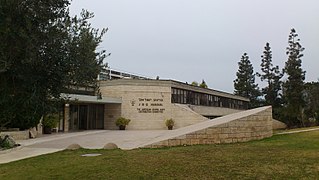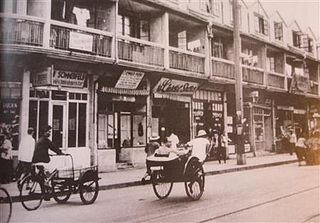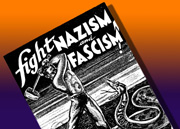Related Research Articles

During World War II, some individuals and groups helped Jews and others escape the Holocaust conducted by Nazi Germany.

The Kindertransport was an organised rescue effort of children from Nazi-controlled territory that took place in 1938–1939 during the nine months prior to the outbreak of the Second World War. The United Kingdom took in nearly 10,000 children, most of them Jewish, from Germany, Austria, Czechoslovakia, Poland, and the Free City of Danzig. The children were placed in British foster homes, hostels, schools, and farms. Often they were the only members of their families who survived the Holocaust. The programme was supported, publicised, and encouraged by the British government, which waived the visa immigration requirements that were not within the ability of the British Jewish community to fulfil. The British government placed no numerical limit on the programme; it was the start of the Second World War that brought it to an end, by which time about 10,000 kindertransport children had been brought to the country.

American Jewish Joint Distribution Committee, also known as Joint or JDC, is a Jewish relief organization based in New York City. Since 1914 the organisation has supported Jewish people living in Israel and throughout the world. The organization is active in more than 70 countries.

Samuel Dickstein was a Democratic Congressional Representative from New York, a New York State Supreme Court Justice, and a Soviet spy. He played a key role in establishing the committee that would become the House Committee on Un-American Activities, which he used to attack fascists, including Nazi sympathizers, and suspected communists. In 1999, authors Allen Weinstein and Alexander Vassiliev learned that Soviet files indicate that Dickstein was a paid agent of the NKVD.
Recorded Jewish history in the Philippines started during the Spanish period.
The Jewish Labor Committee (JLC) is an American secular Jewish labor organization dedicated to promoting labor union interests in Jewish communities, and Jewish interests within unions. The organization is headquartered in New York City, with local/regional offices in Boston, New York City, Philadelphia, Chicago and Los Angeles, and volunteer-led affiliated groups in other U.S. communities. It was founded in 1934 in response to the rise of Nazism in Europe. Today, it works to maintain and strengthen the historically strong relationship between the American Jewish community and the trade union movement, and to promote what they see as the shared social justice agenda of both communities. The JLC was also active in Canada from 1936 until the 1970s.

The Shanghai Ghetto, formally known as the Restricted Sector for Stateless Refugees, was an area of approximately one square mile in the Hongkew district of Japanese-occupied Shanghai. The area included the community around the Ohel Moshe Synagogue. Shanghai was notable for a long period as the only place in the world that unconditionally offered refuge for Jews escaping from the Nazis. After the Japanese occupied all of Shanghai in 1941, the Japanese army forced about 23,000 of the city's Jewish refugees to be restricted or relocated to the Shanghai Ghetto from 1941 to 1945 by the Proclamation Concerning Restriction of Residence and Business of Stateless Refugees. It was one of the poorest and most crowded areas of the city. Local Jewish families and American Jewish charities aided them with shelter, food, and clothing. The Japanese authorities increasingly stepped up restrictions, surrounded the ghetto with barbed wire, and the local Chinese residents, whose living conditions were often as bad, did not leave. By 21 August 1941, the Japanese government closed Shanghai to Jewish immigration.

HIAS is a Jewish American nonprofit organization that provides humanitarian aid and assistance to refugees. It was originally established in 1881 to aid Jewish refugees. In 1975, the State Department asked HIAS to aid in resettling 3,600 Vietnam refugees. Since that time, the organization continues to provide support for refugees of all nationalities, religions, and ethnic origins. The organization works with people whose lives and freedom are believed to be at risk due to war, persecution, or violence. HIAS has offices in the United States and across Latin America, Europe, Africa, and the Middle East. Since its inception, HIAS has helped resettle more than 4.5 million people.

Wilfrid Berthold Jacob Israel was an Anglo-German businessman and philanthropist, born into a wealthy Anglo-German Jewish family, who was active in the rescue of Jews from Nazi Germany, and who played a significant role in the Kindertransport.
The One Thousand Children (OTC) is a designation, created in 2000, which is used to refer to the approximately 1,400 Jewish children who were rescued from Nazi Germany and other Nazi-occupied or threatened European countries, and who were taken directly to the United States during the period 1934–1945. The phrase "One Thousand Children" only refers to those children who came unaccompanied and left their parents behind back in Europe. In nearly all cases, their parents were not able to escape with their children, because they could not get the necessary visas among other reasons. Later, nearly all these parents were murdered by the Nazis.
The Central British Fund for World Jewish Relief, which operates under the name World Jewish Relief, is a British Jewish charitable organisation and is the main Jewish overseas aid organisation in the United Kingdom. World Jewish Relief was formed in 1933 as a support group to German Jews under Nazi rule and played a major role in organising the Kindertransport which rescued around 10,000 German and Austrian children from Nazi Europe. After the war, the organisation brought 732 child Holocaust survivors to Britain; the first 300 are known as The Windermere Children and collectively they are known as The Boys. Currently, World Jewish Relief functions as one of Britain's leading development organizations, working with Jewish and non-Jewish communities alike. World Jewish Relief operates programmes mainly in the former Soviet Union but also in Eastern Europe, Africa, and Asia.

They Were Not Silent is a documentary about the Jewish Labor Committee's anti-Nazi movement in the United States before, during and after World War II. The film features rare archival footage and photographs along with interviews with labor veterans, Holocaust survivors and scholars. It explores how international Jewry worked to help Jews and non-Jews in Germany, Poland, and elsewhere in Europe.
The JLC's role has changed over the years. A trade unionist who has focused on JLC history, Kenneth Burt, says he hopes that the documentary will encourage new interest in the organization.
The history of the Jews in Kobe, Japan, is recorded from the 19th century onwards.

After Adolf Hitler came into power in 1933 and enacted policies that would culminate in the Holocaust, Jews began to escape German-occupied Europe and the United Kingdom was one of the destinations. Some came on transit visas, which meant that they stayed in Britain temporarily, while waiting to be accepted by another country. Others entered the country by having obtained employment or a guarantor, or via Kindertransport. There were about 70,000 Jewish refugees who were accepted into Britain by the start of World War II on 1 September 1939, and an additional 10,000 people who made it to Britain during the war.
The National Refugee Service (NRS) was a refugee aid organization founded in New York City on 15 May 1939 to assist refugees from Europe fleeing Nazi persecution. It represented a reorganization of a predecessor organization, the National Coordinating Committee for Aid to Refugees and Emigrants Coming from Germany (NCC), which had been in operation since 1934 as an umbrella organization of refugee aid agencies.p. 364-365 The National Refugee Service remained in existence until August 1946, when it merged with the Service for Foreign Born of the National Council of Jewish Women to form the new organization United Service for New Americans.
Cecila Davidson Razovsky was a Jewish American social worker and activist for immigrants in the US.

Laura Margolis Jarblum (1903-1997) was the first female overseas representative of the American Jewish Joint Distribution Committee (JDC) and the JDC's first female Country Director.

After Adolf Hitler came into power in 1933, Jews began to escape German-occupied Europe.
The Committee for Jewish Refugees was a Dutch charitable organization that operated from 1933 to 1941. At first, it managed the thousands of Jewish refugees who were fleeing the Nazi regime in Germany. These refugees were crossing the border from Germany into the Netherlands. The committee largely decided which of the refugees could remain in the Netherlands. The others generally returned to Germany. For the refugees permitted to stay, it provided support in several ways. These included direct financial aid and assistance with employment and with further emigration.

Gilbert and Eleanor Kraus were an American couple known for rescuing 50 Jewish children prior to the beginning of World War II.
References
- ↑ Guide to the Records of the German-Jewish Children's Aid, YIVO Institute for Jewish Research, New York.
- ↑ Philip K. Jason; Iris Posner. Don't Wave Goodbye: The Children's Flight from Nazi Persecution to American Freedom . Greenwood Publishing Group; 2004. ISBN 978-0-275-98229-4. p. 3.
- ↑ Richard Breitman and Allan Lichtman. FDR and the Jews . Harvard University Press; 19 March 2013. ISBN 978-0-674-07367-8. p. 121.
- ↑ McCune, Mary. "Cecilia Razovsky." Jewish Women: A Comprehensive Historical Encyclopedia. 20 March 2009. Jewish Women's Archive. (Viewed on April 15, 2016) <http://jwa.org/encyclopedia/article/razovsky-cecilia>.
- ↑ Merle Curti. American Philanthropy Abroad . Transaction Publishers; 1 January 1988. ISBN 978-1-4128-1701-1. p. 386.